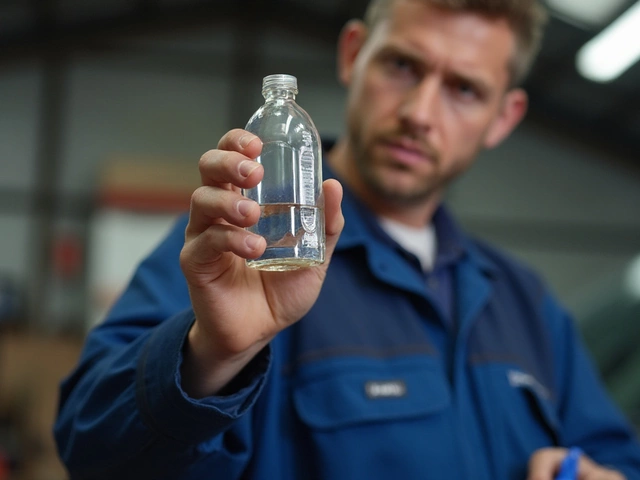Modern cars are a marvel of engineering and technology, often leaving us in awe of their precise operations until something goes awry. One such essential component is the fuel pump; it dutifully ensures fuel is delivered from your tank to the engine, allowing your car to function smoothly. However, like any mechanical part, it can sometimes falter.
For those daunting moments when your car's performance is not quite up to par, a code reader might just become your best friend. These nifty devices can quickly turn a head-scratching mystery into a solvable puzzle by revealing error codes recorded by your car's computer. But can a code reader tell you if your fuel pump is on the fritz? Let's explore the capabilities of these gadgets, their limitations, and how they can help keep maintenance woes at bay.
- Understanding Fuel Pump Issues
- Using a Code Reader for Diagnostics
- Limitations of Code Readers
- Alternative Diagnostic Methods
Understanding Fuel Pump Issues
The fuel pump is often overlooked, but it's a key player in your car’s performance. Located within the fuel tank, this essential component ensures the engine receives a steady flow of fuel under constant pressure, exactly when it needs it. When a fuel pump starts to malfunction, the symptoms can mimic other car problems, which makes diagnosing a faulty pump not always straightforward. Typical signs of trouble include sputtering engines, stalling at high temperatures, decreased fuel efficiency, and, in worst cases, complete failure to start. It can be challenging to determine these issues due to the pump's location and the subtlety of the initial symptoms. Essentially, if your vehicle is acting up and no quick solution is found, the fuel pump should be a suspect.
It’s vital to understand how integral the fuel pump is to your vehicle’s performance. Without a functioning pump, your engine won't receive the fuel it needs to start or maintain power. This crucial part faces wear and tear like any piece of equipment, susceptible to issues over time such as failing seals or electric issues that disrupts its operation. Regular maintenance and attentive care can help prolong its lifespan, but sometimes replacement is the only option, especially if the pump fails suddenly. The wear on these pumps can be exacerbated by running the vehicle low on fuel, which increases the sediment intake and heats up the pump, both damaging behaviors. Thus, maintaining a healthy fuel level is not merely about keeping the journey smooth but also extending the lifespan of the fuel pump itself.
In many cases, car owners may notice the car beginning to "jerk" while driving at a consistent speed. This is often an indication that the fuel pump is not delivering fuel at a steady rate. Additionally, if your car struggles to start in the morning, yet the battery is in good condition, a failing fuel pump might be the root cause. It's quite disconcerting, hearing cranking with no start, especially in the early morning before work. Insights like these highlight how dependent we are on this unseen, unfelt component.
“The fuel system is like the heart of your vehicle, pumping energy to where it's needed. Ensuring it works well means your engine and your car stay strong and reliable,” says Gary Mark, a veteran mechanic with over 20 years of experience at Bristol Motor Services.
A fascinating statistic from the car maintenance experts at Motorists’ Weekly notes that approximately 20% of unexplained engine failures can be traced back to a faulty fuel pump. It underscores how frequent it can be for car owners to grapple with fuel system issues without even realizing it. As vehicle technology continues to integrate more electronic components, the complex systems require more diligent care and precise tools for diagnosis and repair. Therefore, the reliance on a solid and operational fuel pump is more critical than ever.

Using a Code Reader for Diagnostics
For anyone who has encountered the dreaded check engine light, a code reader can be a lifesaver. But when it comes to identifying issues with your vehicle's fuel pump, the usefulness of a code reader depends on understanding how these devices work. A typical code reader accesses the onboard diagnostics system of your car, often referred to as the OBD-II. This system has been standard in most vehicles since the late 1990s. By plugging the code reader into a port usually found under the driver's side dashboard, you can retrieve diagnostic trouble codes (DTCs) that offer clues about potential malfunctions.
Collecting these codes can provide valuable insights, especially when dealing with engine performance issues. Commonly, fuel pump problems might cause a car to experience starting trouble, engine stuttering, or a noticeable decrease in fuel efficiency. These symptoms could trigger codes related to lean or rich fuel mixtures, like P0171 or P0174, which indicate that the engine is receiving too little or too much fuel. It’s essential to note, however, that a specific code for a fuel pump issue does not always exist. Thus, code readers provide indirect clues rather than direct diagnoses.
If the injectors aren't delivering fuel correctly, expect a range of performance issues that could be misleading," says James Willens, a seasoned auto technician and writer for Automotive Digest. "A code reader can point you in the right direction, but it's crucial to verify the issue with further testing and inspection."Fixes for fuel pump-related codes often require more in-depth diagnostic work. This involves listening for a clicking noise from the pump or checking the fuel pressure with a gauge. Some vehicle enthusiasts suggest that while code readers are invaluable, they should be paired with mechanical intuition or professional advice for a comprehensive approach.
When it comes to troubleshooting, the role of a code reader shines particularly for its speed. Instead of spending hours trying to guess what's wrong under the hood, you can have potential issues laid out in minutes. A detailed report can guide whether you're dealing with a minor glitch or something more significant that might require professional attention. But here's the kicker—code readers are not infallible. They often report symptoms, not causes, much like how a fever thermometer might indicate that you're unwell but won't specifically diagnose a cold or flu.
This limitation emphasizes that while a code reader can highlight problems, it cannot replace a thorough diagnostic process by a trained mechanic. They should be viewed as a first-step diagnostic tool. For any inaccuracies or false positives reported by the scanner, cross-referencing information remains key. Searching online forums, consulting your vehicle's manual, or using advanced diagnostic tools can add layers of assurance.

Limitations of Code Readers
Code readers, while incredibly useful, do come with their own set of limitations, especially when diagnosing a faulty fuel pump. These devices primarily communicate with the car's on-board diagnostics system, accessing error codes that indicate abnormalities. However, they do not diagnose mechanical failures directly, which is a crucial point for any car owner to understand. This means that while a code reader can suggest symptoms like misfire or lean condition, it doesn’t expressly state that the fuel pump is the issue. The data provided is more about clues in a mystery rather than solutions to a problem.
Additionally, code readers have a limited scope when it comes to the depth of their diagnostic reach. They extract trouble codes which require further interpretation by an expert or additional equipment. So, if your vehicle displays symptoms such as sudden stalling, difficulty starting, or uneven power delivery, and the code reader throws up a mishmash of codes, it could point toward the fuel pump, but it won't confirm it. Similar symptoms can arise from other issues, such as clogged fuel filters, faulty injectors, or even ignition problems.
Many modern cars possess complex systems with interconnected modules, meaning that a code indicating a fuel-related issue could be the result of an entirely different failure elsewhere. Therefore, relying solely on a code reader to diagnose a car diagnostics issue may lead to wasted time and resources chasing multiple possible causes. In fact, as the automotive technician community often says, “Code readers are tools, not Fortune Tellers.”
It's worth noting that the sophistication of a code reader also determines its diagnostic capabilities. Basic models may only provide simple codes and generic descriptions, offering minimal guidance. More advanced models can offer live data streaming, providing insight into various engine parameters, but such features usually come at a premium cost. For a complete diagnostic approach that confirms a faulty fuel pump, additional testing methods such as a fuel pressure test are recommended to verify the code reader's findings.
“There is no substitute for a comprehensive diagnosis,” notes automotive repair expert John Ibbotson. “A code reader is an essential starting point, but the root cause of a fuel system failure often requires a deeper dive.”

Alternative Diagnostic Methods
In the quest for resolving car troubles, relying solely on a code reader sometimes doesn't cut it, especially when dealing with something as vital as a fuel pump. As technological marvels as they are, these devices occasionally fall short of pinpointing every problem. That's why car enthusiasts and professionals alike often turn to alternative diagnostic approaches, ensuring that every mechanical mystery is uncovered efficiently.
A traditional yet highly effective method that has stood the test of time is the auditory test—listening for that distinct whirring sound of the fuel pump when you turn the key in the ignition. Often located at the rear of the vehicle, this pump should hum consistently during operation. If the sound is absent or inconsistent, it might indicate a problem. It's said, 'A mechanic's best tool is his ear,' and there's a truth to it, as sound can reveal much about a machine's health.
Another versatile technique is the fuel pressure test, which involves attaching a gauge to the fuel rail. This tool provides insight into whether the pressure exerted by the fuel pump meets the required specifications. A significant drop in pressure could spell trouble. Performing this test requires a fuel pressure gauge, but it can save you both time and money by avoiding unnecessary repairs. Many enthusiasts who prefer hands-on diagnosis often swear by this method for its accuracy.
The use of a multimeter, often overlooked, is another effective strategy. This device checks the electrical circuit that powers your fuel pump. By measuring the voltage and continuity, it can verify if the pump receives adequate electrical power. In some cases, an issue with the circuit may mimic symptoms of a bad pump. Regular checks could potentially avert bigger problems down the line, making this humble tool invaluable in any car diagnostic arsenal.
In more advanced garages, diagnostic smoke machines are used to detect leaks within the fuel system. This method involves introducing smoke into the tank and observing any escaping smoke, which might indicate a leak. Such tools have the touch of science fiction, rapidly zeroing in on issues that would otherwise remain hidden. While they might not be found in every home mechanic's toolkit, smoke machines highlight how technology enhances automotive troubleshooting today.
For those who prefer a comprehensive check-up, visiting a professional mechanic could be the most reliable solution. Mechanics often combine various diagnostic techniques to identify and remedy the problem at its core. Their experience, coupled with advanced tools, ensures that repairs are not only effective but lasting. As one seasoned mechanic put it,
'A well-informed mechanic is like a detective with every clue at his disposal.'Such expertise remains unmatched, particularly for persistent or complex issues.






